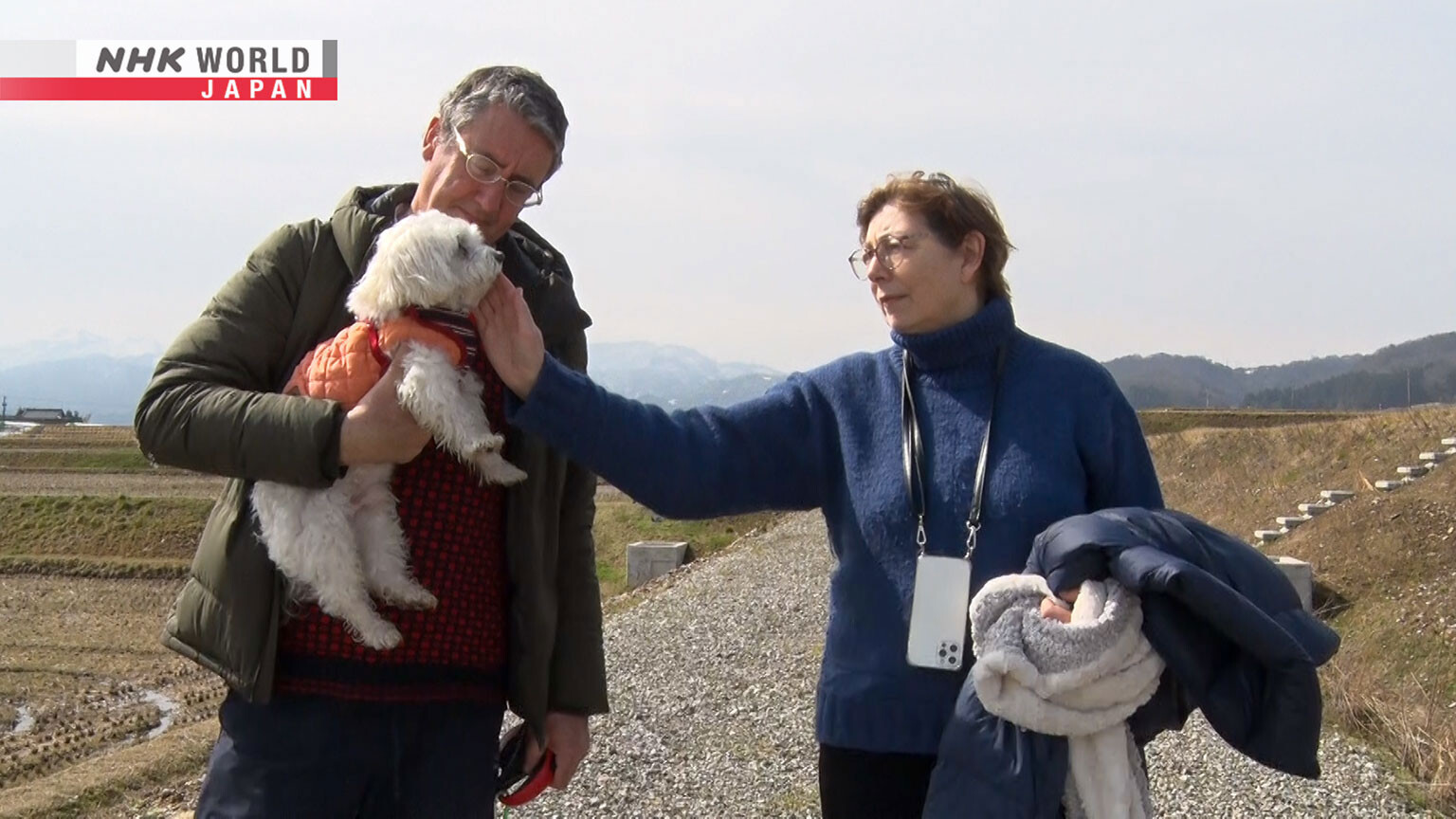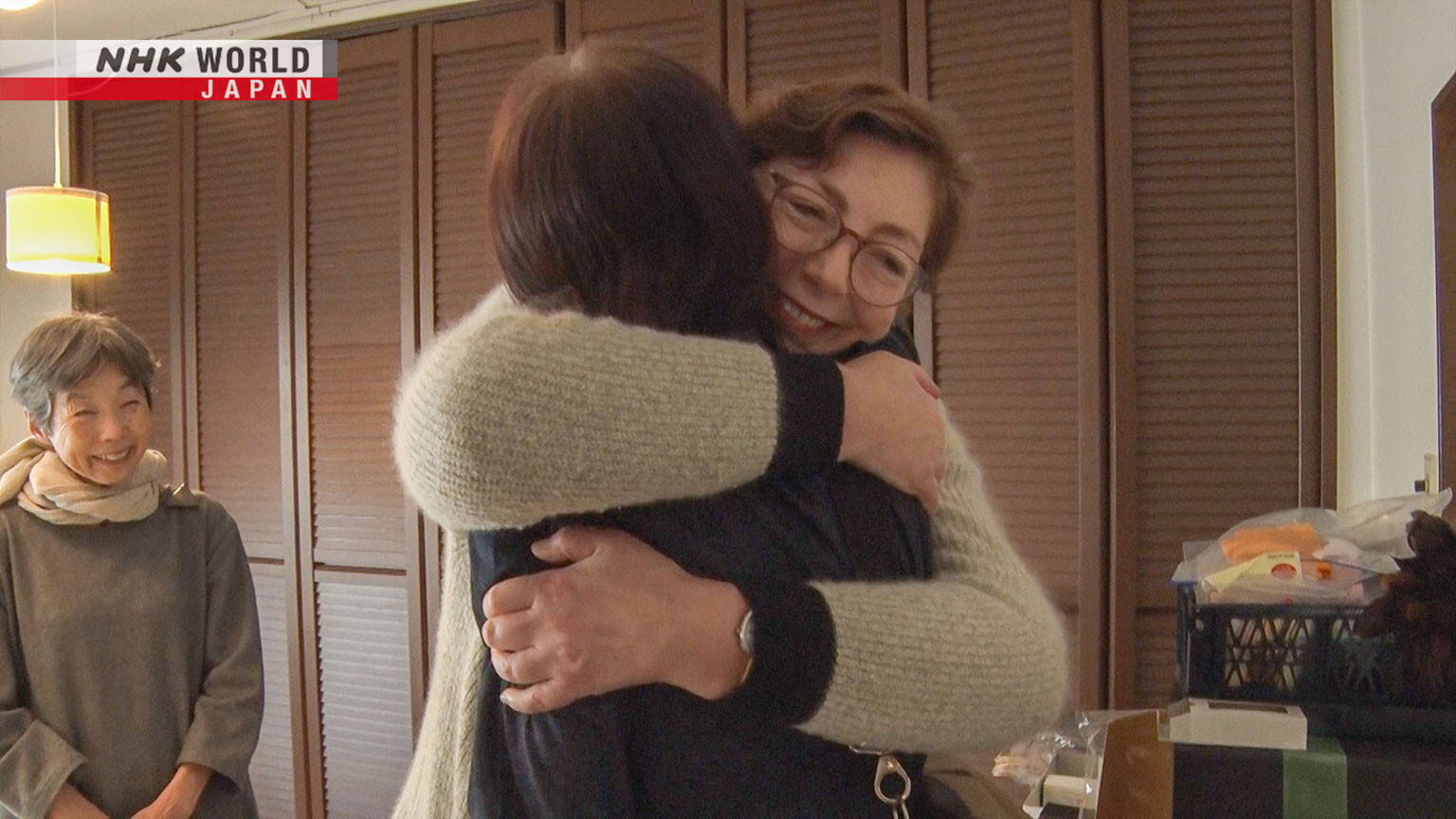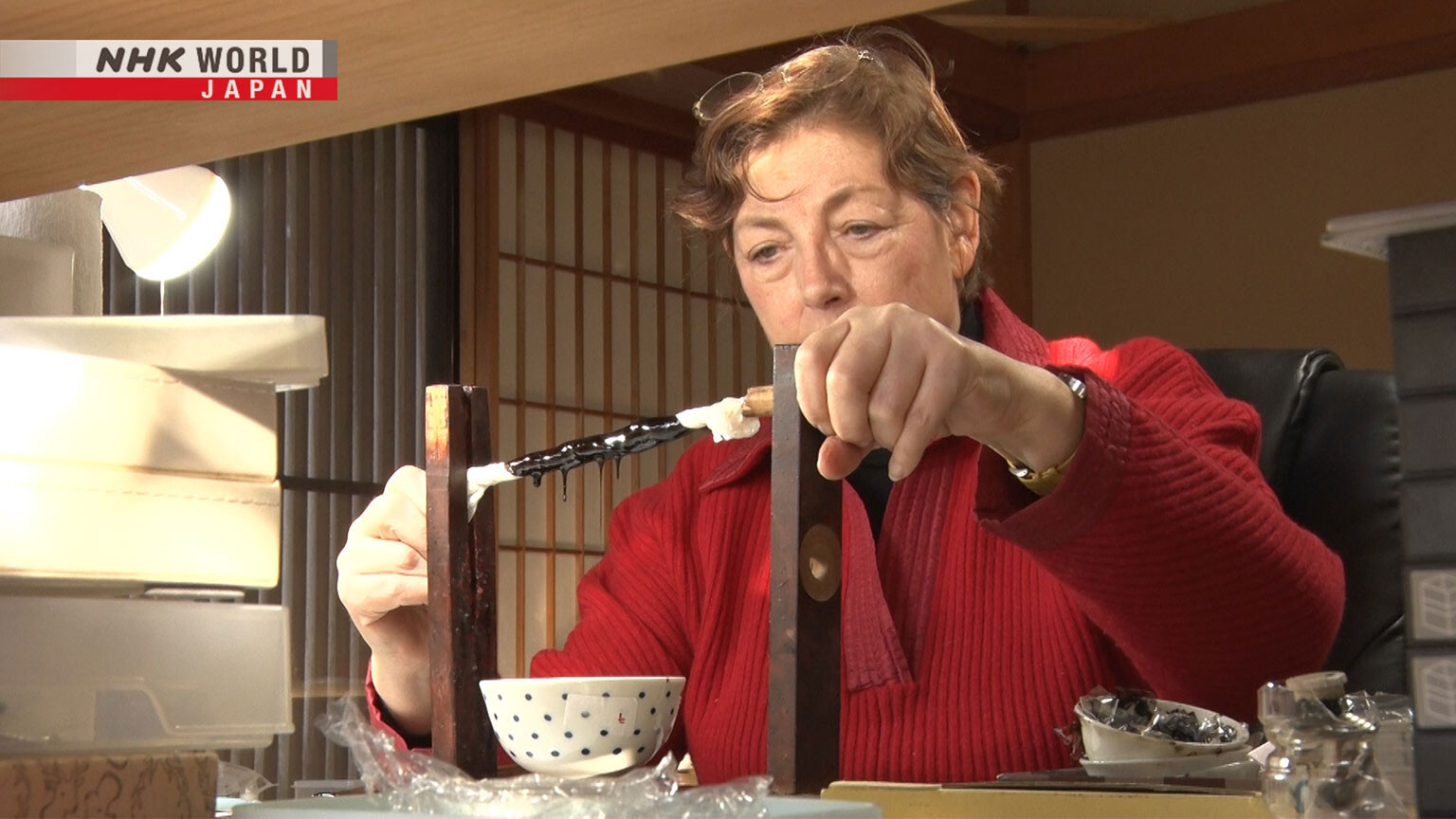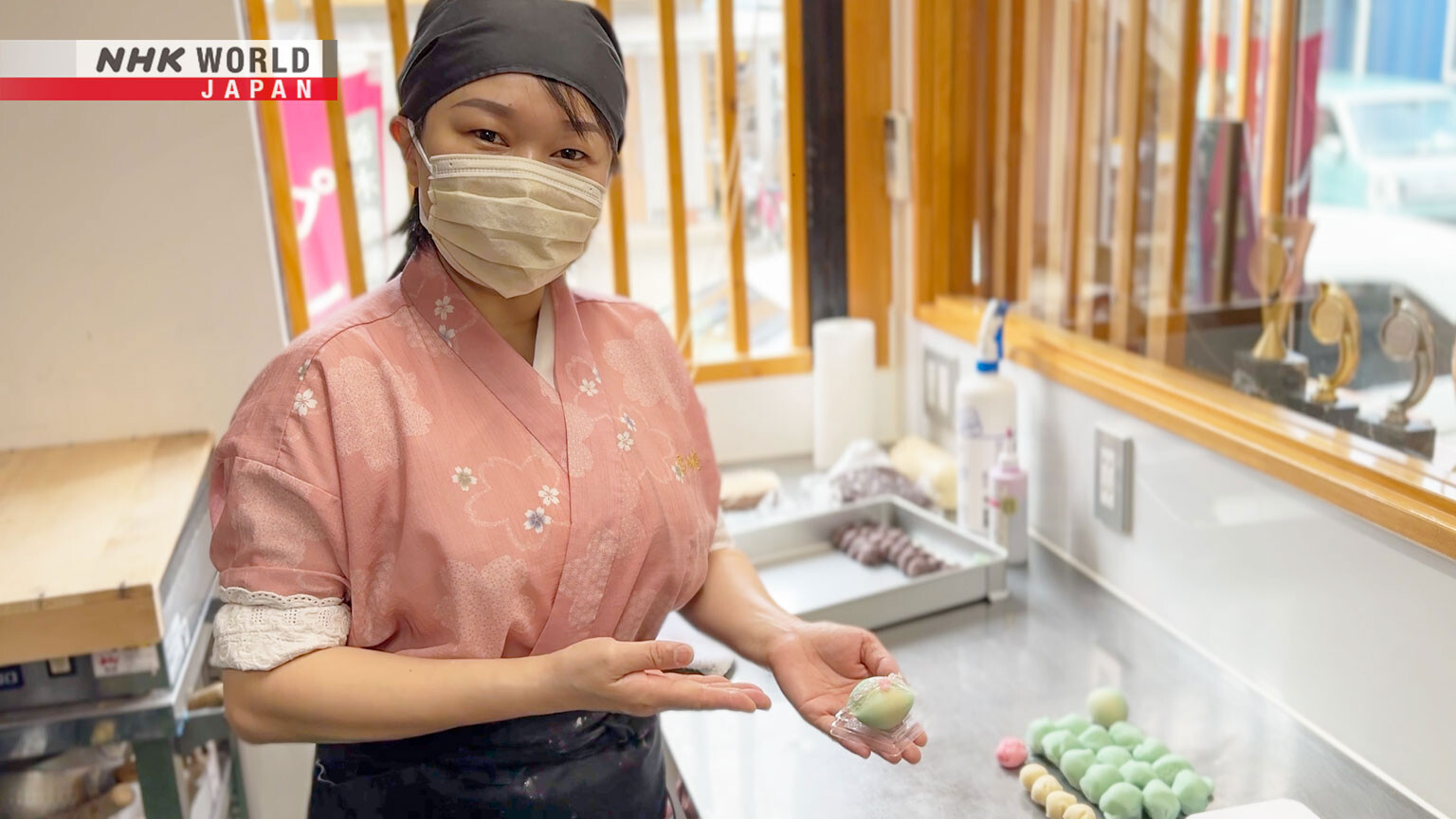Preserving Lacquerware Beyond the Quake
We follow UK-born Suzanne Ross - a lacquerware artisan in Wajima - in her efforts to recover after this January's quake, and meet Chinese Tomoe Setsubai who runs a Japanese confectionery in Yokohama.




Transcript
On January first this year, a massive earthquake struck Ishikawa Prefecture, including the city of Wajima.
The region is famous for its lacquerware.
Elegant and durable, Wajima-nuri is among the best in Japan.
However, most workshops were damaged by the quake, threatening the survival of this traditional craft.
This lacquerware artist has been living in Wajima for over thirty years.
Suzanne Ross from the UK.
I love lacquerware, and I want to preserve Japanese lacquer culture.
She too lost her home and studio in the disaster.
But Suzanne is determined to keep the tradition of lacquerware alive.
Here's a closer look at her efforts.
Nanto City in Toyama Prefecture.
It's in this town some hundred kilometers from Wajima that Suzanne lives as an evacuee.
A friend put her up in this house they weren't using.
However, she doesn't know when, or even if, she'll be able to restart her work.
I was working on these.
This broke during the quake.
Fell off a shelf onto the concrete floor.
It's damaged. It fell hard!
This is quite a chip.
It takes a year to complete a piece.
How will I be able to make a living?
I don't know.
Suzanne was born and raised in London.
While a student, she saw at an exhibition some Japanese lacquerware,
which left a strong impression on her.
The Japanese sense of beauty.
The lacquer adorned with gold and seashell...
and the lacquer's rich, deep black.
It was stunningly beautiful.
Wajima City is one of Japan's major producers of lacquerware.
The region has preserved and nurtured this crafting culture for more than five centuries.
Sturdy yet sumptuously ornate, Wajima-nuri is highly acclaimed, both in and out of Japan.
Its fabrication combines various workmanship skills,
and consists of as many as one-hundred-twenty-four steps.
Traditionally, fashioning a single Wajima-nuri piece involves the work of several artisans.
But Suzanne was determined to learn each and every part of the process, and so she did.
With innovative designs for things like bowls and accessories,
her work pushes the boundaries of tradition.
Exploring the possibilities of lacquerware, her pieces draw attention in Japan and overseas.
She met Clive in England when he was working for a major international oil firm.
Following Suzanne's wish, the two moved to Wajima.
They later got married and raised two daughters.
This was a beloved region they called home.
It was my home.
It was my paradise.
I loved it.
The couple now get by with the support of volunteers.
Among them, Takagi Norihiko has been of great assistance.
He helps them salvage and transport things from their home in Wajima,
and has been keeping a photographic record of their life as evacuees.
Suzanne and Clive really love Japan.
As a Japanese, I'm very grateful.
Today, they head to Wajima to sort through some of the things they left behind.
That landslide, it's unbelievable.
Here too.
They arrive near two old Japanese-style houses at the foot of a mountain where a landslide occurred.
On the right is their house, and Suzanne's workshop is the one on the left.
My car fell down here.
Look at this. Terrifying, isn't it?
The rear wheels were lifted off the ground.
Suzanne was in her workshop when the earthquake struck.
The tremor caused the floor to collapse.
The bridge across the river too fell down.
The house and studio can only be reached by wading through water.
Clive tries to retrieve Suzanne's tools and materials.
But the current is too strong.
This is as much as he can carry.
Suzanne had been renting a gallery in the city to showcase her work.
But as recovery from the disaster seems too far ahead, her lease had to be terminated.
She lost her only base of operations in Wajima.
If I hoped to help Wajima-nuri recover...
I thought I should keep one foot there.
I hate to have to leave Wajima like this.
About a two-and-a-half-hour drive from Wajima is Kanazawa City at the center of Ishikawa Prefecture.
In order to help the tradition of Wajima-nuri recover, Suzanne decided to rent a new workshop here.
However...
Japanese lacquer. It's expensive.
It's stuck!
It's all stuck. I can't take it out!
The lacquer that took so much effort to salvage.
Most of it is too dry to be of any use.
The road to Suzanne restarting her work is long.
She and her husband have to make an important decision.
- I'm tired.
- Yes.
Really tired.
The college where Clive teaches English was also damaged in the quake,
and will move to Tokyo for the foreseeable future.
Plates!
- Don't need any?
- I do.
- How many?
- One.
One?
Just one? OK.
Just one plate in Tokyo?
After much discussion, they decided that Clive will be going to Tokyo alone.
For the two who've been together through good and bad times in this country so far from their own,
it's a heartbreaking decision.
I'll stay in the region of lacquerware.
I want to do my part to help Wajima-nuri recover.
So, we'll have to live separately for a while.
It'd be a shame if she couldn't continue. She's worked so hard.
Really hard.
If I can contribute by earning money, I'll gladly do so.
So that she can continue.
I've so much admiration for her efforts.
The two have no choice but to live apart.
But Clive's strong wish to support his wife's work remains the same
as it was when they got married twenty-five years ago.
Suzanne's insistence on staying close to Wajima stems from her worries for the future of lacquerware.
Making Wajima-nuri is a collaboration.
Removing one step in the fabrication would put everyone else out of work.
Everyone's getting old.
Many don't have the strength to recover, and choose to retire.
I have to do all I can to support Wajima's lacquerware.
Suzanne started to accept orders for bowls.
But instead of doing them all by herself, she decided to share the work with fellow crafters.
However, many artisans who've helped her in the past were forced to close up shop -
some temporarily, others permanently.
I'm going to cry!
Maybe it's over for Wajima.
She found one craftsman who can work with her.
- I wonder if you'd do the final coating.
- Of course.
This artisan specialized in applying the final coating had been unable to work,
as the crafter who took care of the undercoating put their business on hold.
- We gotta keep going.
- Exactly!
It's useless to stay idle.
We can only start by focusing on the task at hand.
Right?
That's right.
Others too are joining in on Suzanne's efforts.
An old friend of hers holds an exhibition.
I want to help Wajima-nuri recover. I share the work with other artisans.
Here, Suzanne is accepting orders for bowls.
Each will take at least one year to complete.
- This one.
- This? OK.
She received a total of forty-one commissions.
Through Suzanne's efforts, the circle of support is growing.
Thank you!
- Thank you.
- Take care.
I'll do my best.
Don't work too hard.
Late March.
The day Clive leaves for Tokyo has come.
Add some chicken.
Cook the chicken first, then the veggies.
- Got it?
- Yes.
Your hair got so long.
The past three months have been riddled with hardships.
But together, they were able to face the difficulties.
Take care!
When will they be able to share a home again?
Neither of them knows.
Suzanne is preparing to get to work on her orders.
She begins by taking the lacquer that can still be used, and breathes life into it.
It's full of dust.
It's been four months. Let's see.
It's lovely! Nice!
- Doesn't it look tasty?
- "Tasty?"
Don't you think so? Like chocolate sauce.
It's beautiful!
I love it.
My baby.
Half of my blood is lacquer. I have to keep going.
But this time, I want to do it slow and steady.
The wounds in my heart are very deep.
So, I want to take the time I need for lacquer to help me heal.
It's the path I chose.
The "Way of Lacquer."
The greenery at the back is nice!
It's my idea!
Hi! Welcome! I'm Tomoe Setsubai.
I came to Japan from China to make Japanese sweets.
Drop by my shop for a break.
Tsurumi Ward. Yokohama, Kanagawa Pref.
In spring, cherry trees bloom along the Tsurumi River.
7:30 a.m. arriving at work.
Setsubai gets changed and she's all set.
First, a sweet called "daifuku."
I gotta use strength.
She kneads a lot of sticky rice flour by hand.
She steams it, then kneads it again with a machine.
Today: strawberries, mandarins, melon, watermelon, kiwi, pineapple...
Six kinds.
Her "fruit daifuku" with large pieces of fruit are a popular line of products.
Some high-end fruit don't work well if their taste is too light.
If they're not tasty, I don't sell them.
She wraps the fruit in the rice cake paste.
I try to be gentle, quick and precise.
After a while, the rice cake hardens.
If customers come in then, I'm a bit nervous.
She then wraps the "daifuku" and puts them on display.
The colorful fruit make the sweets as pretty as they are tasty.
9:00 a.m. opening time.
One strawberry, one blueberry...
- And also, kiwi and melon.
- Kiwi and melon. Thank you.
Can you eat all of them?
We'll do our best!
The fruit "daifuku" are a hit with children too.
Yummy.
Thank you!
Setsubai first tried Japanese sweets when she was in China, and fell in love.
She came to Japan to learn sweets making at a college then worked at several shops.
Even after opening her shop in 2018, her desire to study sweets grew stronger.
The more I learned about them, the more I became fascinated.
I wanted to know more.
I wanted to dive into that world.
This is a high-end fresh confection I call "petal raft."
It represents cherry blossom petals floating on a river.
Time for lunch.
Setusbai has lunch with her colleague.
I made them.
The bento lunches too are very colorful.
I pay attention to that, too.
She prepares tasty and colorful boxed lunches every day. I'm very thankful.
This is my colleague, Arakaki Miki.
Nice to meet you.
Setsubai is like a big sister to me.
She teaches me a lot about Japanese sweets making.
I hope one day I'll be able to attend customers as well as she does.
Miki is like an apprentice, but even more than that...
she's like a little sister to me.
I've never seen someone so earnest.
I can rely on her.
Later, Setsubai hands out sweets to nearby storeowners.
You're too kind!
It's crystalized sugar.
Running a business is tough. Setsubai worked so hard.
She's my Japanese mother.
These are my treasures.
Pictures and letters I got from customers' children.
When I opened my shop, I wanted it to be welcoming for little kids, too.
Their letters make me so happy. I treasure them.
If Japanese people recognize my sweets as authentic Japanese confections...
I'll have succeeded.
It's my ultimate goal.